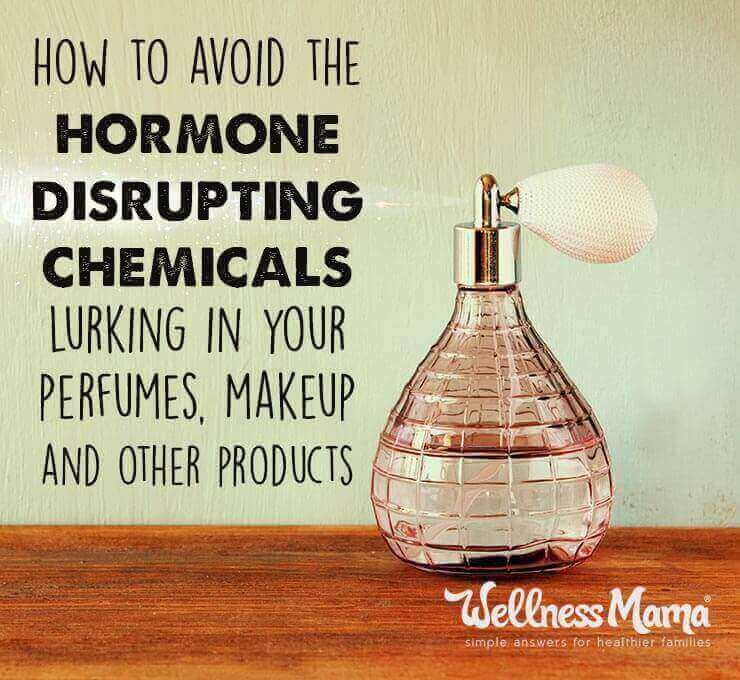What Are Phthalates & Why to Avoid Them | Wellness Mama
Table of Contents[Hide][Show]
For those of us interested in nontoxic personal care, trying to navigate the ever-growing list of chemicals to avoid can be overwhelming. Phthalates are on the Environmental Working Group’s “Dirty Dozen List Endocrine Disruptors,” but what exactly are they and what harm do they cause?
What Are Phthalates?
Phthalates are a group of chemicals used to make certain plastics softer, more flexible, and less fragile. Two million metric tons of them are produced each year!
Sound like a lot? It is… That’s 4,409,245,244 lbs, which equals the weight of 367,437 African elephants or 6 Empire State Buildings! Each. Year.
How Are They Used?
There are over 20 different types of phthalates that are commonly used in hundreds of products, such as:
- Construction materials and industrial products such as vinyl flooring, adhesives, detergents, lubricating oils, automotive plastics, solvents, materials, adhesives, varnishes, and wires and cabling for machines and appliances.
- Home Products: shower curtains, wallpaper, vinyl mini-blinds, food packaging and plastic wrap, garden hoses, printing ink, sporting goods
- Medical Equipment: tubing, storage bags, fluid and blood bags, catheters, feeding tubes, anesthetic, and dialysis equipment
- Toys and Clothing: Inflatable toys, raincoats, rubber boots
- Cosmetics: nail polish, perfume, hair spray
Concerns About Phthalate Exposure
Exposure to phthalates can occur by ingestion, inhalation, and through skin contact. Plastic storage containers can contaminate foods and drinks. We can breathe dust that has come into contact with vinyl wallpaper, mini-blinds, shower curtains, or recently installed vinyl flooring. When we put phthalate-containing cosmetics on our skin and near mucous membranes we can absorb small amounts.
Of particular concern are the phthalates used in medical equipment. It can pose a problem for those who often need IV medical treatments, such as dialysis patients or hemophiliacs who require blood transfusions.
Phthalates and their effects can be an occupational hazard for those who work in plastic manufacturing or with the many industrial products which contain chemicals. Those at risk include individuals who work in home construction and remodeling, painters, printers, and those who work in plastics manufacturing.
At the greatest risk for exposure however are children, especially in-utero during the crucial stages of fetal development. Babies and toddlers under 36 months of age are also at risk because they naturally put things in their mouth, especially their toys (which are often plastic).
Effects of Phthalates?
The greatest concern is the way phthalates affect reproductive organs and hormones, especially in prepubescent males. Some have been linked to breast and other cancers, allergies, obesity, thyroid, and other hormonal disruption.
To understand these risks in greater detail, let’s look at three specific phthalates.
Diethylhexyl Phthalate DEHP/DOP
DEHP or DOP is most commonly used as a plasticizer in polymer products, often in flexible PVC. Flexible PVC (polyvinyl chloride) is used to make a number of products including building materials such as roofing, cables, flooring, and plumbing pipes. DEHP is also used to make blood bags and dialysis equipment.
DEHP is in consumer products such as shower curtains, car interiors, and even exercise balls. The highest exposure from consumer products occurs in children and comes from toys and other products related to childcare. Infants can be exposed to 6 mg/kg/day of DEHP through breastmilk, or 13mg/kg/day through formula.
It is also possible to be exposed to DEHP, and other phthalates through the environment, especially for those who live near industries that use the chemical. Even those who don’t live near manufacturing facilities can be exposed through water runoff from landfills, PVC pipes, and from buildings constructed with DEHP. This is one reason we make it a priority to use air and water filters at home.
Negative Effects
Studies investigating the toxicity of DEHP have shown it affects two organs in particular: the testicles and kidneys. It can increase the size of kidneys, and the occurrence of kidney stones as well as the size of the stones.
DEHP can also cause atrophy of the testes, decreasing their size and under very high dosages causing changes to sperm. It seems that pre-pubescent males are more sensitive to their effects than adults.
Studies also show that DEHP can interfere with the function of the male endocrine system, affect sexual development, and lower fertility in mice and rats.
Based on these studies, the European Union established the amounts of DEHP needed to produce toxicity and negative effects as being equal or greater than the following:
- 4.8mg/kg/day to affect testes and sexual development
- 20mg/kg/day to affect fertility
- 29mg/kg/day to affect the kidneys
For comparison, the highest DEHP exposures come from necessary and lifesaving medical equipment and procedures. Adults receiving long-term hemodialysis will produce DEHP metabolites in the urine at levels of 3.1 mg/kg/day and neonatal blood transfusions can generate metabolite levels of 1.7mg/kg/day in infants.
Diethylphthalate DEP
According to a survey conducted by the FDA in 2010, DEP is the only phthalate still commonly used in cosmetics as solvent and fixative in fragrance. In 2001 the fragrance industry was using around 4,000 tons of DEP annually.
Because of laws in place to protect fragrance formulations, companies do not have to disclose the ingredients of the fragrances put into products such as perfumes, make-up, hair care products, laundry detergents, fabric softeners, or even candles.
Other cosmetic products which often include DEP are bath oils and salts, eye shadow, hair spray, aftershave lotions, nail polish, and nail polish remover.
It can also be found in toothbrushes, plastic packaging, mosquito repellant, and even as an ingredient in aspirin coatings.
The European Union recommends the daily permitted exposure level of DEP to be 4mg/kg/day. This is a much higher level than others because it is considered to be one of the safer phthalates. In animal studies, it took much higher doses than this to produce negative effects.
Developmental Effects
Often, side effects were only observed in the offspring of the rats given doses of DEP, suggesting that the effects may be longer term than what has currently been studied. These developmental defects were delayed ear unfolding, delayed eye opening, and delayed vaginal opening in first generation pups.
Embryo-fetal development studies carried out on mice and rats also observed a reduced number of pups per litter, reduced pup weight at birth, and an increased frequency of skeletal “variations” in pups after pregnant females were given high doses of DEP. Males also had decreased epididymal sperm concentrations.
How DEP Exposure Happens
A 2003 report from the World Health Organization on the chemical stressed that these studies may not prove conclusive. DEP is present in the majority of laboratory equipment, therefore it is difficult to prevent contamination in control groups.
We can be exposed to DEP through food that has been stored or shipped in plastic packaging. One study from Great Britain found that baked goods placed in boxes made from thin cardboard with plastic windows containing DEP had concentrations of the phthalate of 1.7-4.5 mg/kg even though the food had not touched the plastic!
Low levels have even been detected in aluminum foil packaging. Like other phthalates, we can also be exposed to DEP via our water, air, and medical equipment.
Thankfully, surveys conducted in the early 2000s found that the average exposure levels of DEP were way below 4 mg/kg/day. One example is an American survey from 2000 which tested 97 women aged 20 – 40 years and found that the median exposure was 13mg/kg/day, (13 micrograms/kilogram of body weight/day) and the maximum concentration was 170mg/kg/day, which is 23.5 times less than the recommended daily limit of 4mg/kg/day.
Currently, DEP is considered to pose no health threat to humans and is therefore not regulated.
Dibutyl Phthalate DBP
DBP is has a lower molecular weight than other phthalates and is often used in combination with those of higher weights, especially DEHP. It is used as a solvent in many oil-soluble dyes, in printing inks, sealants and grouting agents, adhesives, film coatings, insecticides, other organic compounds, as well as a fiber lubricant in textile manufacturing. It has also been used as a perfume solvent and fixative, a suspension agent for solids in aerosols, a lubricant for aerosol valves, and a plasticizer in nail polish.
A major concern regarding DBP to consumers is its toxicity to reproductive organs and hormone pathways. According to a report published by the Committee for Medicinal Products for Human Use, a subset of the European Medicines Agency, DBP is believed to disrupt the “development of androgen-dependent structures in animals by inhibiting fetal testicular testosterone biosyntheses.”
The European Union has banned the use of this ingredient in toys, childcare articles, and cosmetics. The State of California has classified it as a reproductive and developmental toxicant. Studies have demonstrated that DBP can change the expression of genes important in the synthesis of sex hormones and in the development of the reproductive organs.
DBP has also been correlated with changes in sperm motility and decreased sperm concentration, decreased fertility, and changes in hormone levels in adult men, according to the EWG.
This being said, there is not enough evidence to conclude that is carcinogenic, though some sources suggest that the mounting evidence points to this.
Thyroid Effects
It is not just the reproductive system that is affected either. A 2007 Taiwanese study found that pregnant women with higher concentrations of DBP had a tendency towards hypothyroidism.
Based on these human and animal studies, an acceptable daily intake has been established by toxicologists at the U.S. Consumer Product Safety Commission as 0.2 mg/kg/day. In the European Union, the tolerable daily intake is established as 0.01mg/kg/day.
Phthalates Exposure
The major source of DBP exposure to the general population is via the food supply, followed by drinking water, soil, and ambient air. Some researchers believe that we are getting a sizable exposure to DBP by inhaling it.
Children are once again at the highest risk, because of mouthing behaviors and other exposures. In one study, the teachers and students of a German nursery school were measured for DBP metabolites in their urine. The data showed that the children had three times the amount of DBP in their systems than the adults.
The participants in this study filled out questionnaires to help identify the source of the DBP exposure. From this information, the researchers also concluded that the use of body and skincare products may have had a significant influence on the DBP exposure of the children.
What Is Being Done to Reduce Phthalates?
Thanks to consumer advocacy groups, Congress caught up with the European Union and banned DEHP, DBP, and BBP (butylbenzyl phthalate) to any amount greater than 0.1% (1,000 parts per million) for each individual phthalate in children’s toys or childcare articles that are designed to promote sleep, feeding or drinking, or aid teething or sucking (pacifiers).
Three additional phthalates, DINP (diisononyl phthalate), DIDP (Diisodecyl phthalate), and DnOP (Di-n-octyl phthalate) were also banned on an interim basis to the same amount, but only applied to toys that children could put in their mouth as well as childcare articles.
In 2014, the US Consumer Product Safety Commission (CPSC) proposed another permanent ban of an additional five phthalates from toys and childcare articles. It recommends that DIBP (diisobutyl phthalate), DnPP (di-n-hexyl phthalate), DINP, DPENP, DHEXP and DCHP be permanently banned under the same regulations and it recommended lifting the interim ban on DIDP and DnOP.
It seems that regulations have improved exposure rates, according to a study conducted by the University of California, San Francisco. Even so, while the levels of banned phthalates have decreased companies are replacing them with legal phthalates that have also been shown to cause negative health effects.
How to Limit Your Exposure to Phthalates
Even with the recent regulations, phthalates are ubiquitous in our modern world. While there are many sources that we can’t avoid, there are many ways we can limit our exposure.
1. Use Less Plastic in the Kitchen
You have probably heard me say this one before. Trade plastic food storage containers for glass or ceramic and avoid buying food wrapped in plastic. Opt for reusable produce bags when shopping at the grocery store.
Trying to avoid plastic-wrapped meat can be difficult, especially when shopping at farmer’s markets. Often it means purchasing from the butcher’s counter instead of picking up protein from the meat section or talking to a local farmer about wrapping in paper or other materials.
Resealable plastic bags come in handy for weekly meal preps as a way to store leftovers or chopped vegetables. There are phthalate-free plastic bags available or a better option are these biodegradable bags. We’ve also switched to food-safe silicone storage bags which are not only reusable, but dishwasher safe too.
Since phthalates are oil soluble it is especially important to purchase cooking oils in glass bottles and jars.
2. Avoid Products Made with Vinyl, PVC, and Plastic #3
If you are considering installing floors, try to avoid vinyl flooring especially if you have young children. There are also PVC-free shower curtains which won’t stink up your bathroom for months with volatile organic compounds.
Look for PVC-free air mattresses, and/or cover mattresses with a sure guard mattress protector.
While regulations limit the amount of some phthalates in toys these don’t often apply to school supplies. Avoid plastic backpacks, pencil cases, and binders and opt for cloth or cardboard.
When it comes to toys it can be difficult to limit plastics. However, there are eco-friendly and phthalate-free options available. Or you can opt for non-plastic toys made of wood, cloth, or metal. Blocks, teddy bears, and bicycles are classic toys for a reason!
3. Avoid Fragrances
Since companies do not have to disclose their fragrance ingredients and phthalates are often used to stabilize them, opting for fragrance-free cleaning and beauty products is key. Check out some of my natural and green cleaning recommendations here.
If you miss the “clean scents” of your favorite products you can always add a few drops of essential oils like lemon, lavender, and rosemary, and you can always make your own perfume.
4. Make (or Buy) Natural Beauty Products
When I tell people I make my own beauty products, they often comment that it seems too complicated or that they don’t have the time. This is why I made it my mission to launch my own brand of beauty products! Learn more about my Wellnesse shampoo, conditioner, and toothpaste and what I did to create safe, phthalate-free products for your family in this post.
Of course, if you have always wanted to DIY your own natural toiletries, we’ve got that covered too! With a handful of simple and safe ingredients, you can make your own natural and inexpensive products.
If you are new to DIY beauty products, start with these simple recipes:
This article was medically reviewed by Madiha Saeed, MD, a board-certified family physician. As always, this is not personal medical advice and we recommend that you talk with your doctor.
Were you aware of the dangers of phthalates? Do you avoid them?
Sources:
- Jackson-Browne MS, Papandonatos GD, Chen A, Yolton K, Lanphear BP, Braun JM. Early-life triclosan exposure and parent-reported behavior problems in 8-year-old children. Environ Int. 2019 Jul;128:446-456. doi: 10.1016/j.envint.2019.01.021.
- Li N, Papandonatos GD, Calafat AM, Yolton K, Lanphear BP, Chen A, Braun JM. Gestational and childhood exposure to phthalates and child behavior. Environ Int. 2020 Nov;144:106036. doi: 10.1016/j.envint.2020.106036.
- Shoaff JR, Coull B, Weuve J, et al. Association of Exposure to Endocrine-Disrupting Chemicals During Adolescence With Attention-Deficit/Hyperactivity Disorder-Related Behaviors. JAMA Netw Open. 2020;3(8):e2015041. Published 2020 Aug 3. doi:10.1001/jamanetworkopen.2020.15041
- Kerstin Becker et al. GerES IV: Phthalate metabolites and bisphenol A in urine of German children.
International Journal of Hygiene and Environmental Health 2009, https://doi.org/10.1016/j.ijheh.2009.08.002. - Eyster KM, Mark CJ, Gayle R, Martin DS. The effects of estrogen and testosterone on gene expression in the rat mesenteric arteries. Vascul Pharmacol. 2007;47(4):238-247. doi:10.1016/j.vph.2007.06.007

This article was originally published by wellnessmama.com. Read the original article here.


